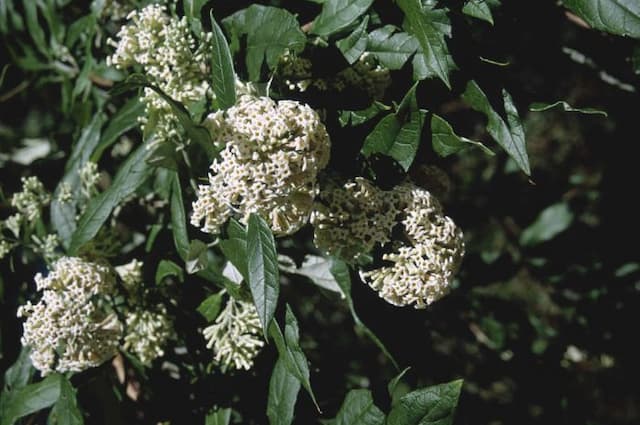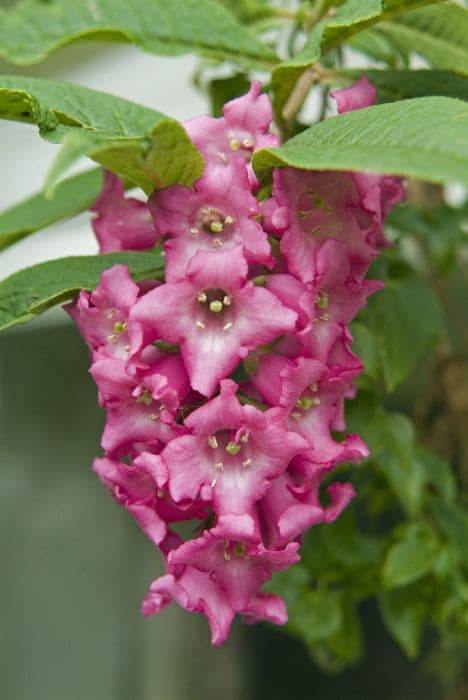Butterfly Bush Buddleja 'Miss Ruby' (PBR)

ABOUT
The Buddleja 'Miss Ruby' is a deciduous shrub known for its striking flower displays and attraction to butterflies. The plant is characterized by an upright and somewhat rounded growth habit, displaying branches that bear lance-shaped leaves. These leaves typically have a deep green color on the upper side with a paler, felt-like underside, offering a pleasant contrast in foliage. Throughout the blooming season, which generally occurs in summer, this shrub is adorned with vibrant pink to magenta flowers. The blooms form in conical clusters known as panicles at the tips of the branches and are renowned for their bright, rich color and sweet fragrance, making them magnets for pollinators like butterflies and bees. The blooms are densely packed along each flower spike, creating eye-catching spots of color that add vibrancy to garden settings. The Buddleja 'Miss Ruby' is appreciated not only for its ornamental value but also for its hardiness and ease of care, making it a popular choice for gardeners looking to add a splash of color and wildlife interest to their landscapes.
About this plant
 Names
NamesFamily
Scrophulariaceae.
Synonyms
Miss Ruby Butterfly Bush, Miss Ruby Summer Lilac.
Common names
Buddleja 'Miss Ruby' (PBR).
 Toxicity
ToxicityTo humans
Miss Ruby Butterfly Bush is not known to be toxic to humans. However, caution is always advised when handling plants, as some individuals may have allergies or adverse skin reactions to certain plant species.
To pets
Miss Ruby Butterfly Bush is not known to be toxic to pets either. While it is always best to discourage animals from eating ornamental plants, ingestion of this particular butterfly bush typically does not result in poisoning or serious health problems. If an animal does consume large amounts of the plant, mild gastrointestinal upset could potentially occur.
 Characteristics
CharacteristicsLife cycle
Perennials
Foliage type
Deciduous
Color of leaves
Green
Flower color
Pink
Height
4-5 feet (1.2-1.5 meters)
Spread
4-5 feet (1.2-1.5 meters)
Plant type
Shrub
Hardiness zones
5-9
Native area
Cultivar
Benefits
 General Benefits
General Benefits- Attracts Wildlife: 'Miss Ruby' butterfly bush is known for attracting bees, butterflies, and other beneficial pollinators to the garden with its fragrant flowers.
- Low Maintenance: This cultivar requires minimal care once established, making it suitable for gardeners who prefer low-maintenance plants.
- Durable: It is relatively drought-tolerant and can survive in a variety of soil conditions, which contributes to its hardiness.
- Long Blooming Period: This butterfly bush has a long flowering season, usually from early summer to the first frost, offering extended color and interest in the garden.
- Compact Size: 'Miss Ruby' has a compact growth habit, making it an ideal choice for smaller gardens or landscaping areas where space is limited.
- Decorative: With its vibrant pink-purple flowers, it adds a burst of color to any garden setting, making it a popular choice for ornamental use.
- Fast Growing: It is known for its fast growth rate, quickly establishing itself and bringing a mature look to new gardens or landscapes.
 Medical Properties
Medical PropertiesThis plant is not used for medical purposes.
 Air-purifying Qualities
Air-purifying QualitiesThis plant is not specifically known for air purifying qualities.
 Other Uses
Other Uses- Photography Prop: Buddleja, commonly known as Butterfly Bush, is often used by photographers as a vibrant, colorful backdrop for nature and wildlife photos, enhancing the beauty of the subject with its striking blooms.
- Artistic Inspiration: The rich, jewel-toned flowers of the Butterfly Bush can serve as a muse for artists, providing a subject for paintings, drawings, and other artistic endeavors.
- Educational Tool: In schools or educational gardens, Buddleja can be grown to help teach students about plant growth, pollination, and the importance of supporting local ecosystems.
- Privacy Screening: The dense growth habit of Buddleja can be utilized in gardens to create natural, living screens that provide privacy for outdoor spaces while adding aesthetic value.
- Theme Gardens: It can be incorporated into thematic gardens, such as fairy or fantasy gardens, to add a whimsical touch with its attractive flowers and the butterflies it draws.
- Memorial Plantings: Due to its beauty and appeal to wildlife, Buddleja can be planted in memory gardens or as a living tribute to loved ones, creating a serene and reflective space.
- Eco-Friendly Crafting: Dried Buddleja branches can be used in eco-friendly crafting projects, such as making natural wreaths or as part of floral arrangements.
- Habitat Restoration: Butterfly Bush can be included in habitat restoration projects to attract pollinators and provide necessary food resources for butterflies and other insects.
- Seasonal Decor: Branches of Buddleja trimmed during pruning can be used to add a natural, seasonal flair to fall and winter decor, either alone or as part of larger arrangements.
- Photodegradation Research: While not its direct use, Buddleja can be a subject of research on photodegradation as its leaves are known to break down certain chemical compounds under sunlight, providing insights into natural mechanisms of environmental cleanup.
Interesting Facts
 Feng Shui
Feng ShuiThe Butterfly Bush is not used in Feng Shui practice.
 Zodiac Sign Compitability
Zodiac Sign CompitabilityThe Butterfly Bush is not used in astrology practice.
 Plant Symbolism
Plant Symbolism- Transformation - Buddlejas, also known as Butterfly Bushes, are associated with transformation due to their ability to attract butterflies, which are symbols of change and metamorphosis.
- Renewal - The fast-growing nature of Butterfly Bushes symbolizes renewal and the ability to bounce back from adversity.
- Attraction - Miss Ruby's vibrant flowers are known to attract a variety of pollinators, which makes it a symbol of magnetism and allure.
- Beauty - Named for its stunning ruby-colored blooms, the plant represents the appreciation of beauty in its many forms.
- Conservation - Since Butterfly Bushes provide habitat for pollinators, they can also be seen as symbols of environmental conservation and biodiversity.
 Water
WaterThe Butterfly Bush should be watered deeply, allowing the soil to become slightly dry between waterings. During the first growing season, establish a deep and extensive root system with regular watering, providing the equivalent of about 1 inch of rainfall per week. As a guide, this is roughly 0.6 gallons per square yard of soil per week. Once established, Butterfly Bushes are quite drought tolerant and will require less frequent watering, possibly once every two weeks unless there are conditions of extreme heat or drought. It's important not to overwater, as this can lead to root rot.
 Light
LightButterfly Bush thrives in full sun but can tolerate partial shade. It performs best with at least 6 hours of direct sunlight each day. Plant it in a location where it will receive ample sunlight during the morning and afternoon to encourage the maximum number of blooms.
 Temperature
TemperatureButterfly Bush is cold hardy and can generally withstand temperatures as low as 0°F and as high as 100°F. However, the ideal temperature range for the Butterfly Bush is between 60°F and 85°F. These shrubs may need some protection from extreme cold or frost, especially when young.
 Pruning
PruningPrune the Butterfly Bush in late winter or early spring to encourage new growth and a more compact habit. Cut back the entire plant to about 1 foot from the ground as it blooms on new wood. Pruning can be done annually, and it is also essential for preventing the plant from becoming too leggy and to promote vibrant blooms.
 Cleaning
CleaningAs needed
 Soil
SoilThe best soil mix for the Butterfly Bush ('Miss Ruby') should be well-draining with a loamy or sandy texture, enriched with organic matter. The ideal pH for this shrub ranges from 6.0 to 7.0. A combination of garden soil, compost, and some perlite or coarse sand would create a suitable environment for healthy growth.
 Repotting
RepottingButterfly Bush ('Miss Ruby') is often planted in the ground where repotting is not required. If grown in containers, repotting every 2-3 years or when it outgrows its current pot can encourage continued health and growth.
 Humidity & Misting
Humidity & MistingButterfly Bush ('Miss Ruby') is adaptable to a wide range of humidity levels and does not require high humidity to thrive. Average outdoor humidity conditions are typically sufficient for this plant.
 Suitable locations
Suitable locationsIndoor
Provide bright light and good air circulation for indoor Butterfly Bush.
Outdoor
Full sun, well-draining soil, and regular pruning for outdoor growth.
Hardiness zone
5-9 USDA
 Life cycle
Life cycleBuddleja 'Miss Ruby', commonly known as Butterfly Bush, begins its life cycle with germination from seed, although commercial propagation is often through cuttings to maintain the cultivar's characteristics. Once rooted, the young plant enters a vegetative stage, characterized by rapid growth of foliage and the development of a robust root system. As it matures, typically within the first year, it enters the flowering stage during the summer months, producing vibrant pink-red flower spikes that attract butterflies and other pollinators. After pollination, seeds are produced and dispersed, although many cultivars, including 'Miss Ruby', are bred to be low or non-seed producing to prevent invasiveness. Following the flowering season, the plant enters a period of senescence in the fall where it begins to go dormant, with leaves turning yellow and dropping. Finally, in winter, the Butterfly Bush remains dormant, with the woody structure of the shrub surviving cold conditions to regrow the following spring.
 Propogation
PropogationPropogation time
Early Spring
Buddleja 'Miss Ruby', also known as Butterfly Bush, is commonly propagated through softwood cuttings. This method is executed in late spring or early summer when new growth is mature enough to be cut but not fully hardened. A typical cutting is taken about 4-6 inches (10-15 cm) long and includes several sets of leaves. The bottom set of leaves is removed, and the cut end is often dipped in rooting hormone to increase the chances of success. The cutting is then inserted into a potting mix and kept moist and warm, with high humidity being beneficial for root development. Roots usually form within a few weeks, after which the new Butterfly Bush can be gradually acclimatized to outdoor conditions before being planted in the garden.

![Butterfly bush [Berries and Cream]](/_next/image?url=https%3A%2F%2Fplants-admin.emdemapps.com%2Fimages%2Fplants%2F%2Fimages%2F604b650f667be.png&w=640&q=75)





![Butterfly bush [Nanho Purple]](/_next/image?url=https%3A%2F%2Fplants-admin.emdemapps.com%2Fimages%2Fplants%2F%2Fimages%2F604b5e3cb2c58.png&w=640&q=75)
